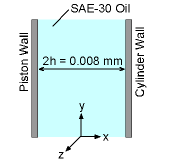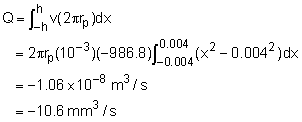| Ch 8. Incompressible and Viscous Flow | Multimedia Engineering Fluids | ||||||
|
Flow between Parallel Plates |
Couette Flow |
Viscous Flow in Pipe |
|||||
| Flow between Parallel Plates | Case Intro | Theory | Case Solution |
| Chapter |
| 1. Basics |
| 2. Fluid Statics |
| 3. Kinematics |
| 4. Laws (Integral) |
| 5. Laws (Diff.) |
| 6. Modeling/Similitude |
| 7. Inviscid |
| 8. Viscous |
| 9. External Flow |
| 10. Open-Channel |
| Appendix |
| Basic Math |
| Units |
| Basic Equations |
| Water/Air Tables |
| Sections |
| Search |
| eBooks |
| Dynamics |
| Fluids |
| Math |
| Mechanics |
| Statics |
| Thermodynamics |
| Author(s): |
| Chean Chin Ngo |
| Kurt Gramoll |
| ©Kurt Gramoll |
| |
||
|
|
From the continuity equation, it can be concluded that the velocity v is a function of x only, i.e, v = v(x). The Navier-Stokes equations are simplified to The first and third equations require the pressure to be a function of y only. If the second equation is integrated twice (assumes dp/dy = constant with respect to x), then Applying the no-slip conditions to obtain the coefficients, and the above equation reduces to |
|
 Velocity Profile |
Note that h is one half of the gap width (h = 0.004 mm). Substituting the known values (i.e., μ = 0.38 N-s/m2, ρ = 912 kg/m3 and dp/dy = 15 MPa/20 mm), and the velocity profile becomes The volumetric flow rate of the leakage can be obtained by integrating the velocity over the cross sectional area as follows:
The negative sign simply indicates that the flow rate is in the negative y direction. Note: Students are encouraged to calculate the Reynolds number and determine if the assumption of laminar flow is valid. |
|
Practice Homework and Test problems now available in the 'Eng Fluids' mobile app
Includes over 250 free problems with complete detailed solutions.
Available at the Google Play Store and Apple App Store.


